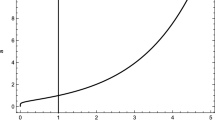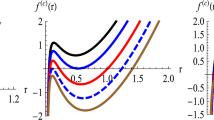Abstract
In this paper, we investigate Bianchi type VI0 universe filled with two minimally interacting fields, matter and anisotropic holographic dark energy components in the scalar–tensor theory of gravitation proposed by Saez and Ballester (Phys. Lett. A 113: 467, 1986). Solving the field equations of the theory using a relation between metric potentials and special law of variation for Hubble’s parameter proposed by Bermann (Nuovo Cimento B 74:182, 1983) we have presented an anisotropic holographic dark energy model in this theory. The physical aspects of the model are also discussed.




Similar content being viewed by others
References
Adhav, K.S., et al.: Astrophys. Space Sci. 332, 497 (2012)
Adhav, K.S., et al.: Astrophys. Space Sci. 353, 249 (2014)
Akarsu, O., Dereli, T.: Int. J. Theor. Phys. 51, 612 (2012)
Akarsu, O., Kilinc, C.B.: Astrophys. Space Sci. 326, 310 (2010)
Akarsu, O., Kilinc, C.B.: Gen. Relativ. Gravit. 42, 763 (2012)
Bennett, C.L., et al.: Astrophys. J. Suppl. Ser. 148, 1 (2003)
Bento, M., et al.: Phys. Rev. D 66, 043507 (2002)
Bermann, M.S.: Nuovo Cimento B 74, 182 (1983)
Bousso, R.: J. High Energy Phys. 07, 004 (1999)
Brans, C.H., Dicke, R.H.: Phys. Rev. 124, 925 (1961)
Caldwell, R.: Phys. Lett. B 545, 23 (2002)
Chiba, T., Nakamura, T.: Prog. Theor. Phys. 100, 1077 (1998)
Cohen, A., et al.: Phys. Rev. Lett. 82, 4971 (1999)
Collins, C.B., et al.: Gen. Relativ. Gravit. 12, 805 (1983)
Feng, B., et al.: Phys. Lett. B 607, 35 (2005)
Fischler, W., Susskind, L.: (1998). arXiv:hep-th/9806039
Harko, T., et al.: Phys. Rev. D 84, 024020 (2011)
Kiran, M., et al.: Astrophys. Space Sci. 354, 577 (2014)
Kiran, M., et al.: Astrophys. Space Sci. 356, 407 (2015a)
Kiran, M., et al.: Astrophys. Space Sci. 360, 54 (2015b)
Naidu, R.L., et al.: Astrophys. Space Sci. 338, 333 (2012b)
Naidu, R.L., et al.: Int. J. Theor. Phys. 51, 1997 (2012a)
Nojiri, S., Odintsov, S.: Phys. Rev. D 68, 123512 (2003)
Padmanabham, T.: Gen. Relativ. Gravit. 40, 529 (2008)
Padmanabham, T.: Phys. Rev. D 66, 021301 (2002)
Perlmutter, S., et al.: Astrophys. J. 517, 5 (1999)
Pradhan, A., et al.: Astrophys. Space Sci. 337, 401 (2012)
Ramesh, G., Umadevi, S.: Astrophys. Space Sci. 361, 50 (2016)
Reddy, D.R.K., et al.: Amaravathi Univ. Res. J. Spl. Issue, 1 (2015)
Reddy, D.R.K., et al.: Prespace time J. 7, 100 (2016)
Riess, A., et al.: Astron. J. 116, 1009 (1998)
Saez, D., Ballester, V.J.: Phys. Lett. A 113, 467 (1986)
Saha, B., Yadav, A.K.: Astrophys. Space Sci. 341, 651 (2012)
Sarkar, S., Mahanta, C.R.: Gen. Relativ. Gravit. 45, 53 (2013b)
Sarkar, S., Mahanta, C.R.: Int. J. Theor. Phys. 52, 1482 (2013a)
Sarkar, S.: Astrophys. Space Sci. 349, 985 (2014a)
Sarkar, S.: Astrophys. Space Sci. 351, 361 (2014b)
Sarkar, S.: Astrophys. Space Sci. 352, 859 (2014c)
Sharif, M., Zubair, M.: Astrophys. Space Sci. 339, 45 (2012)
Singh, T., Chaubey, R.: Pramana 71, 447 (2008)
Susskind, L.: J. Math. Phys. 36, 6377 (1994)
Umadevi, S., Ramesh, G.: Astrophys. Space Sci. 359, 51 (2015)
Yadav, A.K., et al.: (2010). arXiv:1006.5412
Acknowledgements
We thank the reviewer for the constructive comments which have largely helped to improve the presentation of the manuscript.
Author information
Authors and Affiliations
Corresponding author
Ethics declarations
Compliance with ethical standards
The authors declare that they have no potential conflict and will abide by the ethical standards of this journal.
Appendix
Appendix
Equation (4) is \((T^{ij} + \bar{T}^{ij})_{;j} = 0\), where
Here
Similarly \(\bar{T}^{ij}_{;j}\) can be defined. Now using Eqs. (5) and (6), we get Eq. (13). Since we are considering minimally interacting fields we have \(T^{ij}_{;j} = 0\), \(\bar{T}^{ij}_{;j} = 0\) so that, we get Eqs. (14) and (15) for metric (1).
Rights and permissions
About this article
Cite this article
Reddy, D.R.K., Anitha, S. & Umadevi, S. Anisotropic holographic dark energy model in Bianchi type-VI0 universe in a scalar–tensor theory of gravitation. Astrophys Space Sci 361, 349 (2016). https://doi.org/10.1007/s10509-016-2942-6
Received:
Accepted:
Published:
DOI: https://doi.org/10.1007/s10509-016-2942-6




